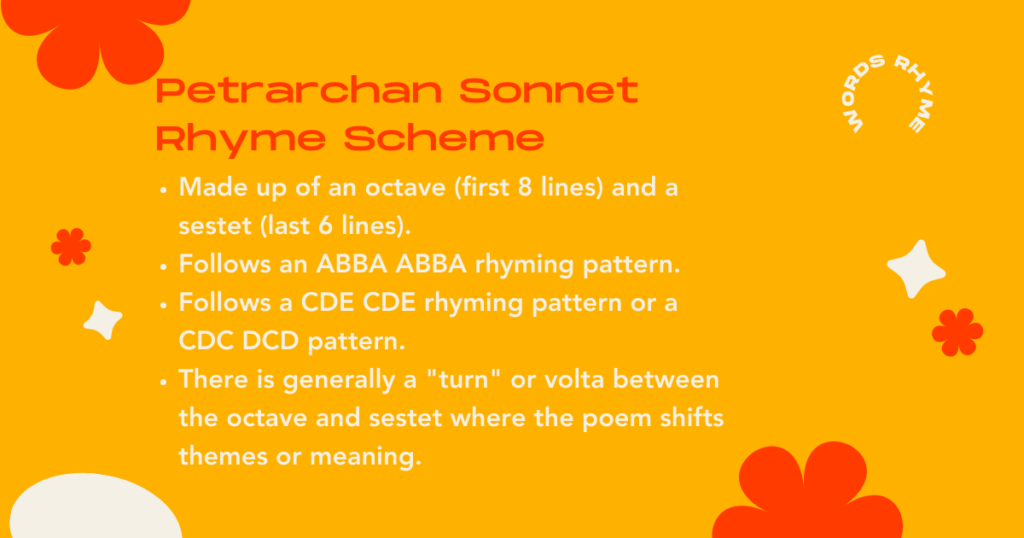In the romantic world of poetry, the Petrarchan sonnet stands as a symbol of the dedicated interplay of structure and emotion. This has been considered a timeless form of sonnet, being able to mesmerise readers with its delicate aesthetic feel and unique rhyme scheme. Join us as we explore more about the Petrarchan sonnet rhyme scheme and its lyrical beauty with a few examples.

Definition of Petrarchan Sonnet Rhyme Scheme
Petrarchan sonnets are defined as a sonnet form named after Francesco Petrarca, a 14th-century Italian poet. Petrarchan Sonnet rhyme scheme’s main characteristic is it is made up of an octave (first 8 lines) and a sestet (last 6 lines) – a combination of 14 lines that are divided into two sections:
- The first section is an eight-line stanza with a rhyme scheme of ABBAABBA (octave)
- The second section is a six-line stanza with a rhyme scheme of CDCDCD or CDECDE (sestet)
There is generally a “turn” or volta between the octave and sestet where the poem shifts themes or meaning.
Examples
Let’s delve into a few examples to have a closer look at the beauty of the Petrarchan Sonnet Rhyme Scheme:
- The Grave of Keats by Oscar Wilde:
Rid of the world’s injustice, and his pain, (A)
He rests at last beneath God’s veil of blue: (B)
Taken from life when life and love were new (B)
The youngest of the martyrs here is lain, (A)
Fair as Sebastian, and as early slain. (A)
No cypress shades his grave, no funeral yew, (B)
But gentle violets weeping with the dew (B)
Weave on his bones an ever-blossoming chain. (A)
O proudest heart that broke for misery! (C)
O sweetest lips since those of Mitylene! (D)
O poet-painter of our English Land! (C)
Thy name was writ in water—it shall stand: (D)
And tears like mine will keep thy memory green, (C)
As Isabella did her Basil-tree. (D)
- Sonnet 43 By Elizabeth Barrett Browning
How do I love thee? Let me count the ways.
I love thee to the depth and breadth and height
My soul can reach, when feeling out of sight
For the ends of being and ideal grace.
I love thee to the level of every day’s
Most quiet need, by sun and candle-light.
I love thee freely, as men strive for right.
I love thee purely, as they turn from praise.
I love thee with the passion put to use
In my old griefs, and with my childhood’s faith.
I love thee with a love I seemed to lose
With my lost saints. I love thee with the breath,
Smiles, tears, of all my life; and, if God choose,
I shall but love thee better after death.
Have you found yourself captivated by the beauty and structured elegance of the Petrarchan Sonnet rhyme scheme? The ABBAABBACDCDCD rhyme scheme of the Petrarchan Sonnet has become a tool for expressing complicated feelings. The structured elegance of the form allows poets to discover themes of passion, affection, and the intricacies of human emotions. Through thoroughly chosen words and rhyme patterns, poets have been able to craft beautiful, timeless expressions.


